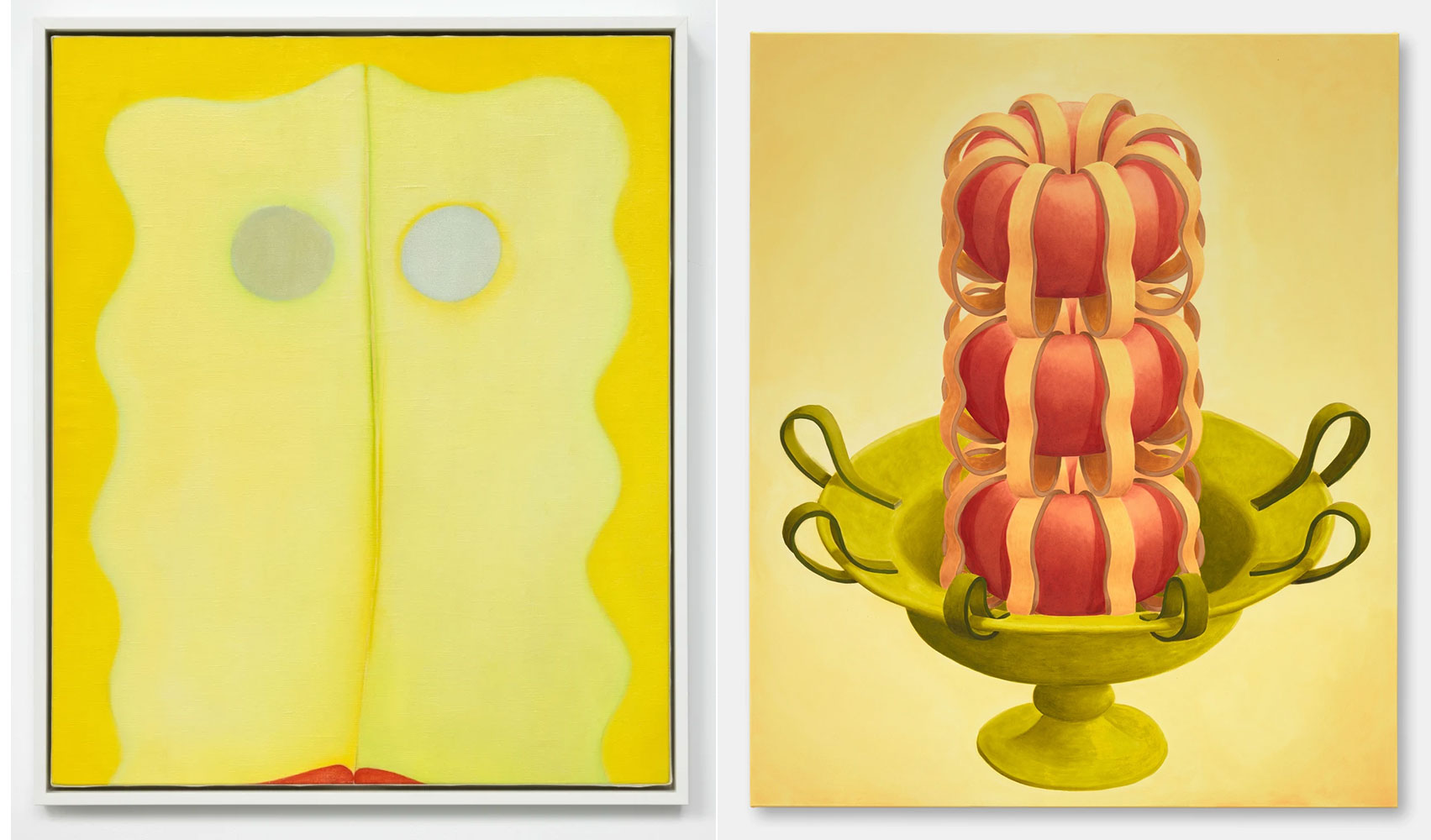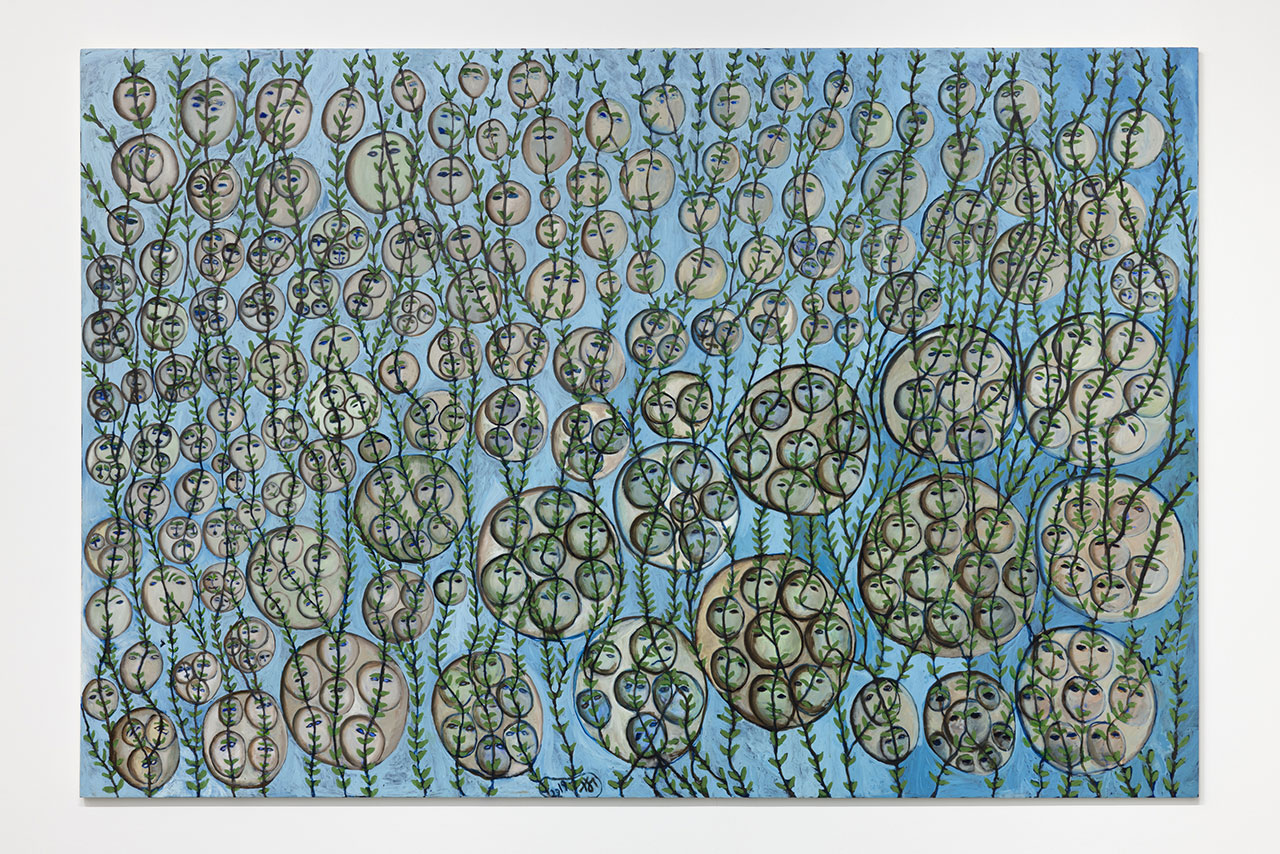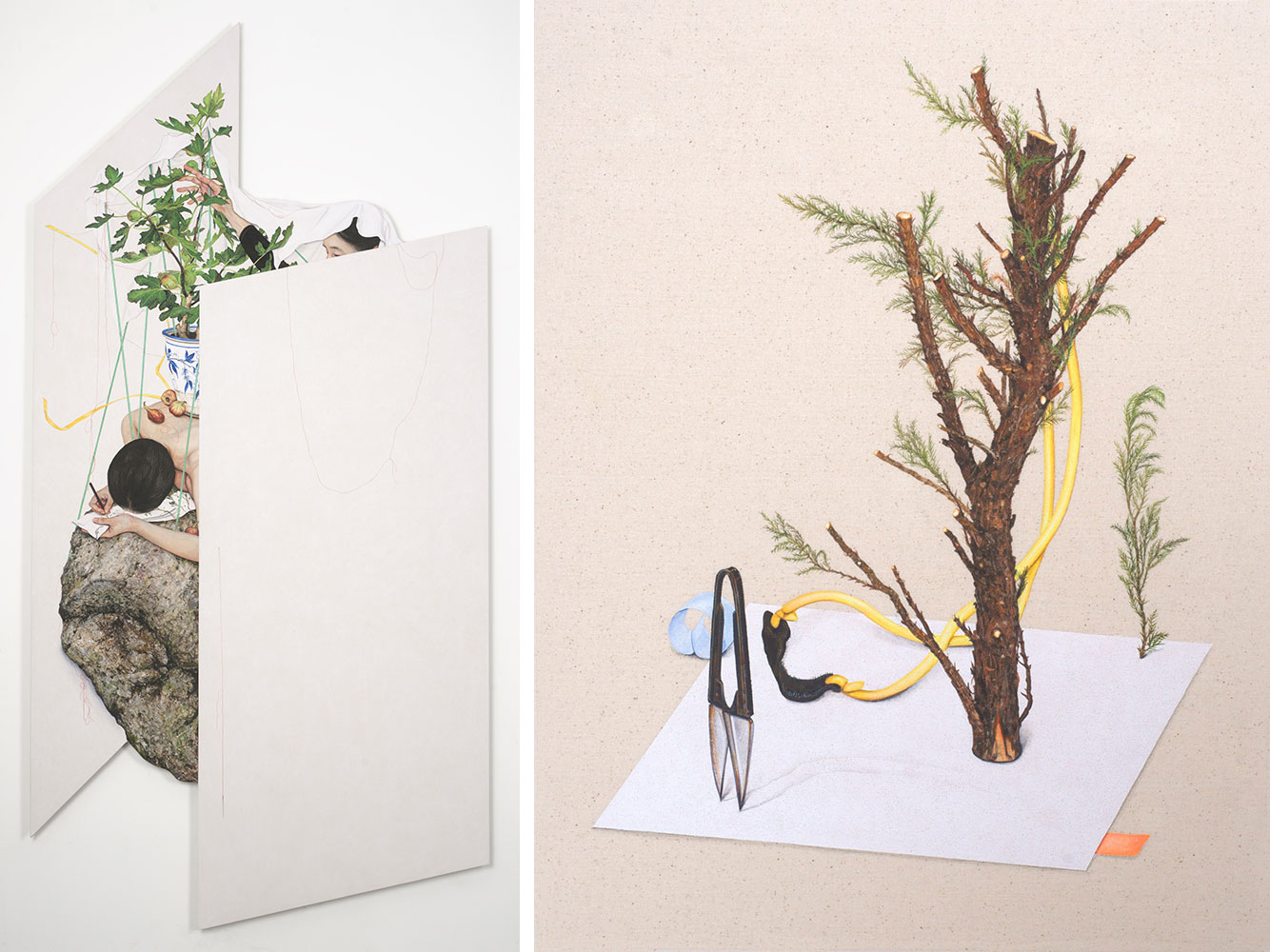PRESENTATION: Twilight is a Place of Promise
 The group exhibition “Twilight is a Place of Promise” features the work of 19 international artists born between 1895 and 1996. The exhibition offers a perspective on the politics of image-making—personal, social, political, historical—taking painting and the artists’ diverse approaches to the practice as its focus. It is partisan in its polysemy, insistent only on the confluence of nuance and power.
The group exhibition “Twilight is a Place of Promise” features the work of 19 international artists born between 1895 and 1996. The exhibition offers a perspective on the politics of image-making—personal, social, political, historical—taking painting and the artists’ diverse approaches to the practice as its focus. It is partisan in its polysemy, insistent only on the confluence of nuance and power.
By Efi Michalrou
Photo: Esther Schipper Gallery Archive
Emerging three years after the Esther Schipper’s Gallery 2021 exhibition “L‘Invitation au voyage”, which invoked the freedom of imaginary travel in the form of fantasy or dreams, the exhibition “Twilight is a Place of Promise” presents works of painters that look beyond conventional categorizations of subject and object, external and internal worlds. The works in the exhibition imagine spaces of inwardness, spirituality, and shared humanity, with the show’s title inspired by Harryette Mullen’s poem “The Only Ones”. The exhibition proposes an expanded understanding of painting beyond categories such as abstract and figurative, oil or pigment-based and collage or object-based. A central objective of the exhibition is to set aside fixed ideas of what are masculine or feminine characteristics of painting. The exhibition’s selection reevaluates assumptions about the meanings of form, subject matter and technique and their connection to the painter’s identity. The works in the exhibition have in common a fearless negotiation of circumstance, identity and form. Another important theme of the exhibition is the choice to paint and live as an artist, decisive acts with social and political repercussions. Exhibited artists have devised unique approaches to the practice: be it by refusing overt subject matter and finding meaning in shapes, pattern and structures; by focusing on domestic and intimate scenes; by taking motifs such as the nude, historically the realm of male painters, and claiming it for themselves; or by appropriating found imagery and reworking it. The exhibition highlights diversity and fluidity. The five elements of the architecture, built in wood and metal, converge in the center of the space to create multiple points of crossing, putting the works in dialogue and productive tension. In addition to a full digital presence with written and visual documentation, a program of talks with selected artists accompanies the exhibition. Eileen Agar was born in 1899 in Buenos Aires and died in 1991 in London. In 1911, Agar moved to London, where she studied at the Slade School of Fine Art in London before leaving in the late 1920s to live and work in Paris. Agar is a significant figure in the history of surrealism, who used art to capture and reflect the tensions and anxieties of her era, including the experience of living through two World Wars. Bettina von Arnim was born in 1940 in Zernikow, Germany. From 1960 to 1965, she studied at the Berlin University of the Arts before moving to France in 1975. Bettina von Arnim’s paintings are often dystopic, melding man and machine into ominous constructions that warn of the autocratic power of technology. Merikokeb Berhanu was born in 1977 in Addis Ababa, Ethiopia. The artist currently lives in Addis Ababa and the US. Berhanu received a BA in Fine Arts from the Addis Ababa University in 2002. Berhanu’s early work focused on lifeforms and biomorphic imagery. In recent works, new symbols – such as circuit boards or fish skeletons – have emerged as the artist grapples with the implications of a society estranged from nature. Huguette Caland was born in 1931 in Beirut, Lebanon, where she studied art at the American University of Beirut. Caland lived and worked in Beirut, Paris, and New York before settling in Los Angeles in 1987. She returned to Beirut shortly before her death in 2019. Caland rebelled against contemporary cultural and social norms. Her abstract works examine and unfold the female body in paintings that are at once playful and erotic yet defy easy objectification. Caroline Coon was born in 1945 in London, where she works and lives. Coon studied Fine Art at Central Saint Martins in the mid-1960s, opting for a medium and subject deemed unfashionable at the time – figurative painting. Inspired by feminism and the politics of sexual liberation, Caroline Coon’s paintings contest binary notions of gender and patriarchal values. Her works have a variety of subjects including sex workers, beachgoers, intersex people, football players, urban landscapes and still lifes. All are united by Coon’s unwavering rebellion against the status quo. Hélène Delprat was born in 1957 in Amiens, France and lives and works in Paris. She graduated from the École Nationale Supérieure des Beaux-Arts. Between 2014-2023 Delprat was Professor at ENSBA – Ecole Nationale Supérieure des Beaux Arts de Paris. Over the past four decades, oscillating between fiction and documentary, humor and melancholy Delprat’s multifaceted practice has engaged the human condition as its focus, exploring life and death in an oeuvre that includes painting, drawing, photography, sculpture, video, theater, interview projects and installations. Bracha L. Ettinger, born in 1948 in Tel Aviv, is a visual artist, feminist theorist, psychoanalyst, philosopher, and creator of ‘matrixial theory’. Ettinger received a PhD in Aesthetics of Visual Arts from the University of Paris VIII, a DEA in Psychoanalysis from the University of Paris VII and a MA in Clinical Psychology from the Hebrew University of Jerusalem. Ettinger founded the Centre for Cultural Analysis, Theory, and History at the University of Leeds. Her work often investigates generational and personal trauma as well as historical figures, especially important women. Roey Victoria Heifetz was born in 1978 in Jerusalem and studied at the School of the Museum of Fine Art, Boston in 2003, the Department of Fine Art, Bezalel Academy of Arts and Design, Jerusalem from which she received a BFA in 2005, and in 2009 a MFA. Heifetz’s work examines women’s bodies on a monumental scale. Seeking to increase their visibility, she especially focuses on figures who are aging or in transition.
Andrea Joyce Heimer was born in 1981 in Great Falls, Montana, USA. The artist received an MFA in Painting from the New Hampshire Institute of Art in 2017, and is currently pursuing a PhD in Philosophy, Art, and Critical Thought at the European Graduate School, Saas-Fee, Switzerland. A frequent topic of Heimer’s work is loneliness, a theme informed by the artist’s own story of adoption. The depiction of intricate is influenced by the artist’s interest in ancient Greek imagery. Monilola Olayemi Ilupeju is a Nigerian-American artist and author, born in 1996 in the United States and currently living in Berlin. A graduate of New York University, where she studied studio art and social and cultural analysis, she attended Skowhegan School of Painting and Sculpture, Madison. Through painting, writing, performance and installation, Ilupeju balances intimate experiences of connection, violence, and healing against broader observations on cultural distortion and identity. Earnestly (2022, Archive Books) is her debut collection of writing. Kamala Ibrahim Ishag, born in 1939 in Omdurman, Sudan. From 1959 to 1963, Ishag studied at the College of Fine and Applied Art of the Khartoum Technical Institute, later University of Science and Technology, and continued her education in painting, illustration, and lithography at the Royal College of Art in London from 1964 to 1969. Ishag is one of the most important living painters from East Africa. Ishag is best known for her role in the history of Sudanese modernism and her documentation of the Zār ceremonies predominantly practiced by women. Pia Krajewski was born in 1990 in Cologne, Germany. In 2018 she graduated with masters degree from Kunstakademie Düsseldorf after studying painting in the classes of Prof Andreas Schulze and Dietmar Lutz. Krajewski finds productive tension between familiarity and foreignness, drawing from historical objects and abstract patterns whose legibility slowly erodes as they grow to fill the canvas. Jinju Lee was born in Busan, South Korea, in 1980. Lee received a BA and MA in Eastern painting from Hongik University and completed a PhD in Oriental Korean Philosophy at Sungkyunkwan University. Currently a professor of Eastern Painting at Hongik University, Jinju Lee paints in a traditional Korean technique. Her practice includes observations from daily life, speaking to personal and societal trauma, and to the way in which memory and fantasy can merge. Iva Lulashi was born in 1988 in Tirana and currently lives and works in Milan. In 2016, Lulashi graduated from the Academy of Fine Arts in Venice where the artist attended Atelier F directed by Professor Carlo di Raco. In Iva Lulashi’s erotic figurative scenes, whose visual language is informed by communist propaganda and porn, exploitation and eroticism intertwine to produce a strong sense of narrative ambivalence and underlying threat. Isabel Nolan was born in Dublin, Ireland, in 1974. Nolan received a BA in Fine Art and History of Art from the National College of Art & Design, Dublin, a postgraduate degree from the University College Dublin and an MA in Visual Arts Practices from the Institute of Art, Design and Technology, Dun Laoghaire. The artist has an expansive practice across cosmological phenomena, religious reliquaries, literary figures, and Greco-Roman art, rendered across diverse media. Pan Yuliang was born in 1895 in Yangzhou, China, and died in 1977 in Paris. In 1920, Pan Yuliang was among the first female students to enroll at the Shanghai Art School. She studied in France at the Institute Lyon, Ecole National des Beaux Arts Lyon, in 1921, and the Ecole National Superieure des Beaux Arts de Paris, in 1923. Pan Yuliang was the first Chinese female artist to paint in a Western style, and one of the first Chinese students to study in Paris. She is best known for her portraits of women, both as more formal sitters and in intimate settings. Yuliang returned to Paris in 1937 and remained there until her death. Isabel Quintanilla was born in 1938 and died in 2017 in Madrid. The artist studied at the Escuela Superior de Bellas Artes in Madrid from 1953 to 1959 and in Rome at the Institute of Art and Restoration from 1960 to 1964. She graduated from the Complutense University in Madrid with a degree in painting in 1982. Quintanilla’s work is associated with the new Spanish realism movement, and she was a member of the group Realistas de Madrid (Madrid Realists). Her paintings and drawings, often depicting everyday objects or still lifes, are renowned for their expert handling of textures and capturing atmospheric diffused light. Anys Reimann was born in 1965 in Melsungen, Germany. Initially trained as an interior designer and architect, in 2020 Reimann received a Master’s degree from the Kunstakademie Düsseldorf, where she studied sculpture and painting. Often executed in a collage-like style, Reimann’s work blends abstraction and figuration, creating portraits that reflect the artist’s bicultural Afro-German heritage and personal experiences. Cecilia Vicuña was born in 1948 in Santiago, Chile. Vicuña received a MFA from the National School of Fine Arts, University of Chile in 1971 and continued with postgraduate studies at the Slade School of Fine Art, University College London from 1972-1973. Vicuña integrates practices of poetry, performance, conceptualism, and textile craft in response to pressing concerns of the modern world, including ecological destruction, human rights, and cultural homogenization. The artist works and lives in New York.
Works by: Eileen Agar, Bettina von Arnim, Merikokeb Berhanu, Huguette Caland, Caroline Coon, Hélène Delprat, Bracha L. Ettinger, Roey Victoria Heifetz, Andrea Joyce Heimer, Monilola Olayemi Ilupeju, Kamala Ibrahim Ishag, Pia Krajewski, Jinju Lee, Iva Lulashi, Isabel Nolan, Pan Yuliang, Isabel Quintanilla, Anys Reimann, and Cecilia Vicuña
Photo Left: Huguette Caland, Untitled (Bribes de corps), 1978, Oil on linen, 72,4 x 59,7 cm, © Huguette Caland, Courtesy the artist and Esther Schipper, Berlin/Paris/Seoul. Photo Right: Pia Krajewski, Auf dem Silbertablett, 2024, Oil on canvas, 180 x 150 cm, © Pia Krajewski, Courtesy the artist and Esther Schipper, Berlin/Paris/Seoul
Info: Esther Schipper Gallery, Potsdamer Strasse 81E, Berlin, Germany, Duration: 29/6-24/8/2024, Days & Hours: Tue-Sat 11:00-18:00, www.estherschipper.com/


Right: Merikokeb Berhanu, Untitled XCVII, 2024, Acrylic on canvas, 152,4 x 101,6 cm, Photo © J.Bendzulla, Courtesy of the artist, Addis Fine Art, and Esther Schipper, Berlin/Paris/Seoul

Right: Lee Jinju, Such, 2023-2024, Powdered pigment, animal skin glue, and water on unbleached cotton, 44 x 34 cm, © Lee Jinju,, Courtesy the artist and Esther Schipper, Berlin/Paris/Seoul

Right: Pia Krajewski, Metamorphosis 1: Die Gestaltwandlerin, 2024, Oil on canvas, 250 x 200 cm, © Pia Krajewski , Courtesy the artist and Esther Schipper, Berlin/Paris/Seoul
